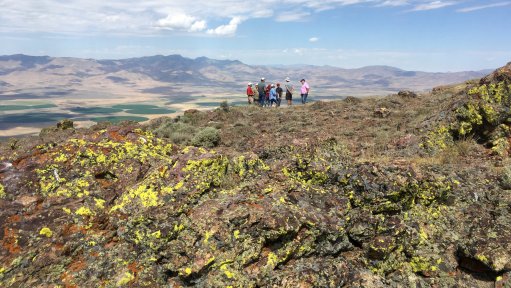Substantive mineral law issues still far from resolved – Herbert Smith Freehills

Herbert Smith Freehills associate Ben Winks outlines to Mining Weekly Online’s Martin Creamer minerals sector sticking points. Photographs: Duane Daws. Video: Nicholas Boyd. Video Editing: Lionel da Silva
JOHANNESBURG (miningweekly.com) – The content and the implications of the Minerals and Petroleum Resources Development Act (MPRDA) Amendment Bill are extraordinarily complicated.
Three issues, which embody the most significant negative implications for the mining industry and South Africa, have been delaying the finalisation of the Bill, which was tabled in 2013, passed in 2014 and referred back to Parliament by the President Jacob Zuma in 2015.
At a media roundtable chaired by Herbert Smith Freehills head Peter Leon, addressed by Herbert Smith Freehills director Patrick Leyden and attended by Creamer Media’s Mining Weekly Online, Herbert Smith Freehills associate Ben Winks said the substantive issues that remained and which were far from resolution were:
• the failure of the Bill to separate mining from upstream petroleum;
• the export restrictions the Bill placed on strategic minerals; and
• the provisions in the Bill that gave the Minister of Mineral Resources legislative powers that really belong to Parliament.
Both the strategic minerals issue and the conferring of law-making power on the executive were part of President Zuma’s reservations that resulted in the Bill being sent back to Parliament.
Subsequent to the refer back, the offshore and onshore petroleum industries and elements within government itself considered that the referral might be an opportunity to deal with the issue of separating oil and gas from minerals so that they could be differently regulated on the basis that they are different. (Also watch attached Creamer Media video).
The debate on separating mining from oil and gas goes back to 2002 when the MPRDA was first enacted.
At that time, the then Department of Minerals and Energy (DME), as it was under the Mbeki administration, dismissed suggestions by industry that the two should be regulated separately as it seemed efficient for what was then a single department to deal with the two industries collectively in one piece of legislation, the MPRDA.
At that stage of limited upstream petroleum activity, the upstream Petroleum Agency of South Africa (Pasa) was already in existence as was the Liquid Fuels Charter for upstream, midstream and downstream petroleum industries.
But in 2002, the separate streams of activity were all brought together under one Act until 2009, when the first Zuma administration split the DME into two separate departments, with certain responsibilities being left with the new Department of Mineral Resources (DMR) and others going with the Department of Energy (DoE).
Upstream petroleum was left straddling the two departments, with Pasa deriving its power from the DMR but being owned by the Central Energy Fund, which falls under the DoE.
In the corporate sense, Pasa is answerable to the DoE but in the regulatory sense to the DMR, which has created awkward departmental tension.
Also, from an empowerment perspective, upstream petroleum is governed by the Liquid Fuels Charter, which is very different from the Mining Charter.
The Liquid Fuels Charter is monitored and administered by the DoE, because it applies to midstream and downstream petroleum as well, and the Mining Charter is administered by the DMR.
There are very different methodologies in the two charters and also different targets.
The Liquid Fuels Charter requires upstream petroleum companies to be 10% black-owned whereas the Mining Charter requires mining companies to be 26% black-owned.
The difference is really quite substantial in a practical sense and not simply a form of theoretical distinction.
Moreover, the separate regulation under one Act has created an uneasy coexistence, giving rise to the hope that this uneasy coexistence could be resolved by separating out the petroleum chapters from the MPRDA into a new upstream Bill.
The stakes of this separation became considerably higher in 2011 when the US Energy Information Agency released studies to the effect that South Africa hosts 485-trillion cubic feet of recoverable shale gas in the Karoo basin alone, which put this country in sixth place globally.
The potential for offshore petroleum exploration drilling was also being highlighted after large oil discoveries offshore of neighbouring Mozambique.
As a net petroleum importer, South Africa has considerable benefit to derive from tapping onshore and offshore petroleum reserves.
But it remains unclear as to which department would control upstream petroleum should it be separated out.
DMR does not seem to be on board with the DoE proposition that it should control upstream petroleum and has been proceeding on the basis that upstream petroleum will be regulated by a regional office of the DMR.
It is likely that in the next few months, while the MPRDA Amendment Bill is being reconsidered by Parliament, this will be one of the critical issues.
The excitement on the potential oil and gas boom has not materialised because of this legislative deadlock.
Exploration has simply not been happening and foreign investors have not been able to proceed because the legislative framework is so uncertain.
“There is some urgency to resolving this, at least to provide some kind of certainty to potential investors,” Winks commented.
STRATEGIC MINERALS EXPORT RESTRICTIONS
The first reservation of the President when he referred the Bill back to Parliament was around the restrictions being placed on the export of designated minerals.
The Bill’s provisions give the Minister of Mineral Resources the power to determine minerals that are of strategic value to South Africa and restrict them to compulsory domestic consumption.
There would be a restriction imposed on the export of minerals like platinum, because of South Africa’s dominance in the precious metal, as well as coal and iron-ore to allow domestic companies to have access to cheap coal for power and cheap iron-ore for steelmaking.
But in imposing export restrictions so that domestic downstream industries can have preferential access to leverage comparative advantage violates international trade law and the reservation was expressed that South Africa could face a complaint at the World Trade Organisation if the measure is passed in its current form.
This could disadvantage South Africa in exporting in other sectors including agriculture.
LEGISLATIVE POWER TO THE MINISTER
The Bill currently defines the Act in such a way that its legislative force will be given to instruments published by the Minister of Mineral Resources, including the codes of good practice for the mining industry, housing and living standards and the Mining Charter.
It empowers the Minister to amend the Mining Charter at will, which violates the constitutional separation of powers between Parliament and the executive.
The Constitution lays down that laws are made by Parliament, with its public participation process and proper notice periods so that the law can be clear, predictable and accessible – the three fundamental features of the principle of legality, which is part of the rule of law.
If the Minister is empowered to write and rewrite the rules at the stroke of a pen without any deliberation and consultation as Parliament is required to do, it violates the rule of law, which has to be clear, predictable and accessible.
Much of the public reaction to Mining Charter Three, which was released surprisingly in April, has been the result of its being proposed out of the blue without any prior consultation or deliberation, as Parliament would have been forced to conduct if it was passing a law.
Yet, what is proposed is that the new charter be given the force of law and none of the safeguards. (Also watch attached Creamer Media video).
Comments
Press Office
Announcements
What's On
Subscribe to improve your user experience...
Option 1 (equivalent of R125 a month):
Receive a weekly copy of Creamer Media's Engineering News & Mining Weekly magazine
(print copy for those in South Africa and e-magazine for those outside of South Africa)
Receive daily email newsletters
Access to full search results
Access archive of magazine back copies
Access to Projects in Progress
Access to ONE Research Report of your choice in PDF format
Option 2 (equivalent of R375 a month):
All benefits from Option 1
PLUS
Access to Creamer Media's Research Channel Africa for ALL Research Reports, in PDF format, on various industrial and mining sectors
including Electricity; Water; Energy Transition; Hydrogen; Roads, Rail and Ports; Coal; Gold; Platinum; Battery Metals; etc.
Already a subscriber?
Forgotten your password?
Receive weekly copy of Creamer Media's Engineering News & Mining Weekly magazine (print copy for those in South Africa and e-magazine for those outside of South Africa)
➕
Recieve daily email newsletters
➕
Access to full search results
➕
Access archive of magazine back copies
➕
Access to Projects in Progress
➕
Access to ONE Research Report of your choice in PDF format
RESEARCH CHANNEL AFRICA
R4500 (equivalent of R375 a month)
SUBSCRIBEAll benefits from Option 1
➕
Access to Creamer Media's Research Channel Africa for ALL Research Reports on various industrial and mining sectors, in PDF format, including on:
Electricity
➕
Water
➕
Energy Transition
➕
Hydrogen
➕
Roads, Rail and Ports
➕
Coal
➕
Gold
➕
Platinum
➕
Battery Metals
➕
etc.
Receive all benefits from Option 1 or Option 2 delivered to numerous people at your company
➕
Multiple User names and Passwords for simultaneous log-ins
➕
Intranet integration access to all in your organisation



















